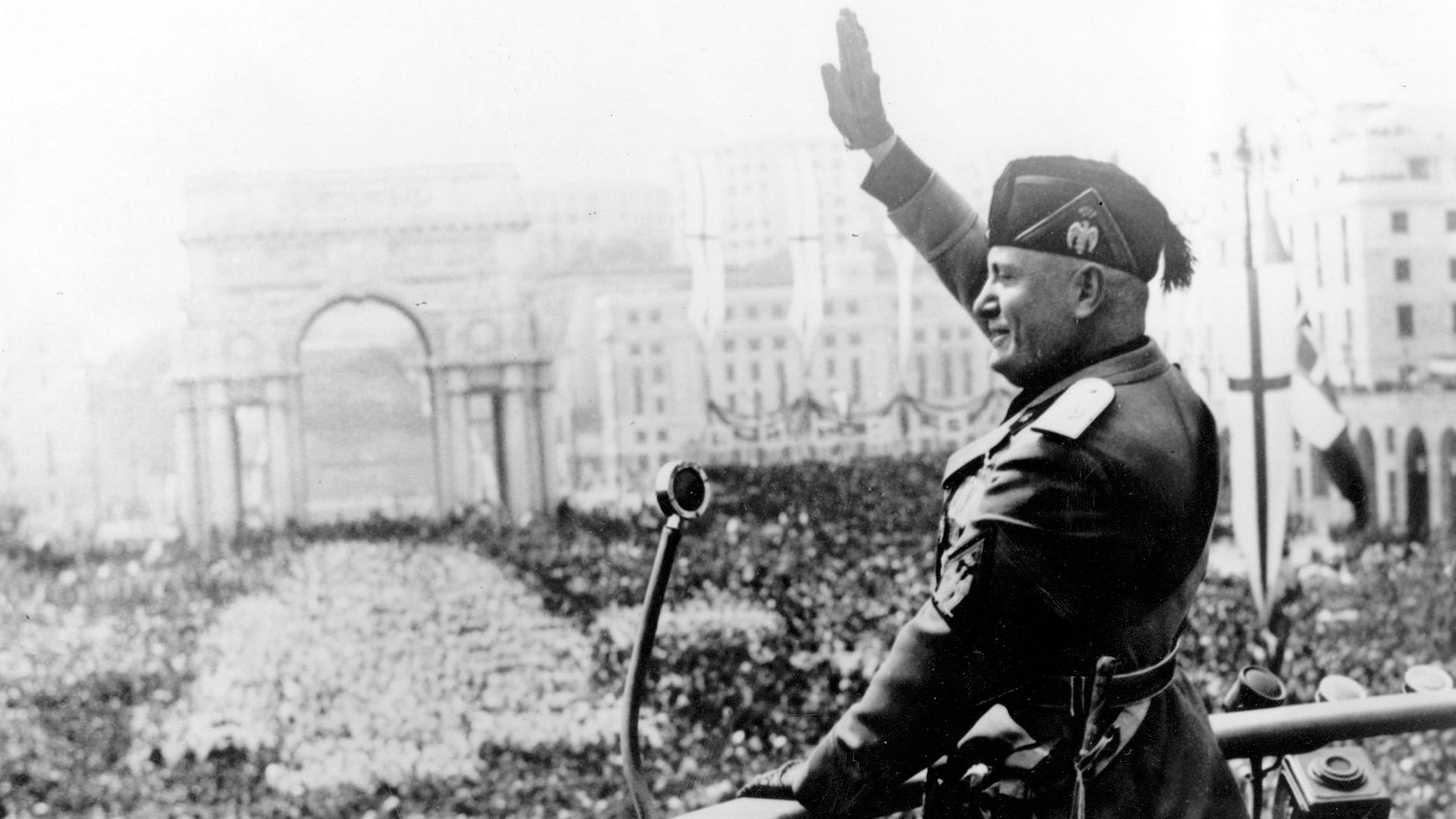Some Italians, supporting Gabriele d’Annunzio (18631938), seized the city of Fiume, which had not been awarded to Italy by the Treaty of London. D’Annunzio ran his own government in Fiume until the end of 1920.
In November 1920, when the Italian government signed the Treaty of Rapallo with Yugoslavia by which Fiume was to become a free city, Italian forces drove d’Annunzio out. But d’Annunzio’s techniques of force, haranguing of mobs from a balcony, straight-arm salute, black shirts, rhythmic cries, and plans for conquest inspired Benito Mussolini (1883-1945), founder of Italian fascism.
Between 1918 and 1922 Mussolini created and brought to power a new political force in Italy. In October 1922 he was summoned to office by King Victor Emmanuel III (r. 1900-1946) and gradually created a totalitarian state of which he was the undisputed ruler. Suppressing all opposition at home and threatening the peace abroad, fascist Italy served in some degree as a model for the Nazis in Germany, for the Falangists in Spain, and for totalitarian regimes in virtually all the European successor states of the Habsburg and Ottoman empires.
Mussolini was born in 1883; his father was a socialist who had begun his career as an anarchist under the influence of Bakunin. Trained as an elementary school teacher, Mussolini was a passionate socialist himself when young, and he was imprisoned for opposing the war against Turkey over Tripoli (1911). In 1912 he became editor of the most important Italian socialist newspaper, Avanti (Forward).
When World War I began, Mussolini opposed Italy’s entry. He loathed militarism, was himself a draft dodger, and urged soldiers to desert the army. A vehement atheist, he also opposed nationalism and referred to the Italian flag as “a rag to be planted on a dunghill.”
But then, during 1914, Mussolini changed his mind, favoring “relative neutrality”—meaning that socialists should leave themselves free to support Italian entry if such a course seemed likely to prove favorable to them. When the Italian Socialist party refused to follow this idea, he resigned as editor of Avanti and founded his own newspaper, II Popolo d’Italia (The People of Italy), in Milan and began to advocate an immediate Italian declaration of war on the side of the Allies. For this the Socialist party expelled him.
After his expulsion from the Socialist party, Mussolini agitated for war, speaking to groups of similarly minded young men called fasci (the image is of a bundle of rods, a symbol of office in the Roman Republic of antiquity). Soon after Italy entered the war in 1915, Mussolini was drafted and sent to the front. He was wounded in 1917; when out of the hospital, he again edited his newspaper. In 1919 Mussolini founded the first fasci di combattimento (groups for combat).
During 1920 and 1921 the industrialists and landowners, squeezed by taxation and inflation, became bitter. Shopkeepers and tradespeople wanted the street disorders to end and food prices to be regulated. Professionals and others with fixed incomes suffered, as prices and wages went up and salaries lagged behind. The police grew tired of suppressing local disorders; ex- servicemen, insulted by anarchists and communists for their war records, grew more patriotic.
All these groups identified those they did not like as Bolsheviks. After a series of fascist-socialist street fights and riots, these anti-Bolsheviks began to look to Mussolini’s fascist bands to defend their interests. D’Annunzio’s defeat left Mussolini as his natural heir. The leftist opposition to Mussolini was further weakened when the communists split off from the Socialist party in 1921. The fascists grew enormously, from 30,000 in May 1920, to 100,000 in February 1921, to more than 300,000 in October 1922.
Liberal parliamentary leaders of Italy felt that the fascist bands were teaching the left a useful lesson, so they encouraged army officers to issue rifles, trucks, and gasoline to the fascists and assigned officers to command their operations. The police were encouraged to look the other way during disorders started by fascists, and local judges were urged to help by releasing arrested fascists. Mussolini’s newspaper was circulated free to the soldiers in the army.
A campaign of terror now began against the socialists and Christian Democrats, as the fascist squadrons cruised around Italy in trucks, burning down labor union offices, newspaper offices, and local Socialist party headquarters and attacking labor leaders and local antifascist politicians. An estimated two thousand people—antifascist and fascist, police and bystanders—died by violence between October 1920 and October 1922. Mussolini had demonstrated that control over sources of information, rapid mobility, and the use of terror and intimidation could effectively silence opposition in a divided and frightened society.
In the elections of May 1921 Mussolini and thirty- four other fascists were elected to the Chamber of Deputies (the lower house of the Italian parliament), along with ten Nationalists, their political allies. The momentum of the fascist movement was now too great to be slowed down.
Fascism became a political party in November as a necessary step in the drive for power. Too late, the government became alarmed and tried to take measures against the fascists, but the squadrons were too strong, the police too accustomed to collaborating with them, and the liberal politicians themselves as yet unaware that a tightly directed armed mob could take over the state.
In the fall of 1922 it was clear that the army would not resist a fascist coup in Rome. When a decree of martial law was presented to the king, he refused to sign it, probably influenced by his knowledge that the army would not fight the fascists and that his cousin would gladly take his crown. The cabinet resigned, and on October 29 the king telegraphed Mussolini in Milan to come to Rome and form a cabinet. Mussolini arrived by sleeping car the next morning, just ahead of thousands of followers.

